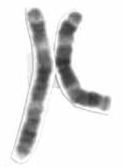Chromosome 3 is one of the 23 pairs of chromosomes in humans. People normally have two copies of this chromosome. Chromosome 3 spans almost 200 million base pairs (the building material of DNA) and represents about 6.5 percent of the total DNA in cells.
Identifying genes on each chromosome is an active area of genetic research. Because researchers use different approaches to genome annotation their predictions of the number of genes on each chromosome varies. In January 2017, two estimates differed by 16%, with one estimate giving 2,971 genes, and the other estimate giving 2,565 genes.
The following are some of the genes located on chromosome 3:
AMOTL2: encoding protein]] Angiomotin-like protein 2
APEH: encoding enzyme Acylamino-acid-releasing enzyme
AZI2: encoding protein 5-azacytidine-induced protein 2
C3orf23: encoding protein Uncharacterized protein C3orf23
C3orf60/NDUFAF3: encoding enzyme NADH dehydrogenase [ubiquinone] 1 alpha subcomplex assembly factor 3
C3orf70: encoding protein C3orf70 (Chromosome 3 Open Reading Frame 70)
ALAS1: aminolevulinate, delta-, synthase 1
BTD: biotinidase
CACNA2D3: calcium channel, voltage-dependent, alpha 2/delta subunit 3
CCR5: chemokine (C-C motif) receptor 5
CNTN4: Contactin 4
COL7A1: Collagen, type VII, alpha 1 (epidermolysis bullosa, dystrophic, dominant and recessive)
C3orf14-Chromosome 3 open reading frame 14: predicted DNA binding protein.
MITF: microphthalmia-associated transcription factor
MLH1: mutL homolog 1, colon cancer, nonpolyposis type 2 (E. coli)
OXTR: oxytocin receptor
PTHR1: parathyroid hormone receptor 1
SCN5A: sodium channel, voltage-gated, type V, alpha (long QT syndrome 3)
SLC25A20: solute carrier family 25 (carnitine/acylcarnitine translocase), member 20
TMIE: transmembrane inner ear
VHL: von Hippel-Lindau tumor suppressor
FOXP1: Forkhead Box Protein P1
CRBN: Cereblon protein
ADIPOQ: adiponectin
CAMPD1: Camptodactyly
CPOX: coproporphyrinogen oxidase (coproporphyria, harderoporphyria)
HGD: homogentisate 1,2-dioxygenase (homogentisate oxidase)
IFT122: intraflagellar transport gene 122
MCCC1: methylcrotonoyl-Coenzyme A carboxylase 1 (alpha)
PCCB: propionyl Coenzyme A carboxylase, beta polypeptide
PDCD10: programmed cell death 10
PIK3CA: phosphoinositide-3-kinase, catalytic, alpha polypeptide
RAB7: RAB7, member RAS oncogene family
RHO: rhodopsin visual pigment
SOX2: transcription factor
USH3A: Usher syndrome 3A
ZNF9: zinc finger protein 9 (a cellular retroviral nucleic acid binding protein)
Diseases and disorders
The following diseases and disorders are some of those related to genes on chromosome 3:
3-methylcrotonyl-CoA carboxylase deficiency
3q29 microdeletion syndrome
Acute Myeloid Leukemia (AML)
Alkaptonuria
Arrhythmogenic right ventricular dysplasia
Atransferrinemia
Autism
Autosomal Dominant Optic Atrophy
ADOA Plus Syndrome
Biotinidase deficiency
Blepharophimosis, epicanthus inversus and ptosis type 1
Breast/colon/lung/pancreatic cancer
Brugada syndrome
Castillo fever
Carnitine-acylcarnitine translocase deficiency
Cataracts
Cerebral cavernous malformation
Charcot-Marie-Tooth disease, type 2
Charcot-Marie-Tooth disease
Chromosome 3q duplication syndrome
Coproporphyria
Dandy-Walker syndrome
Deafness
Diabetes
Dystrophic epidermolysis bullosa
Endplate acetylcholinesterase deficiency
Essential tremors
Ectrodactyly, Case 4
Glaucoma, primary open angle
Glycogen storage disease
Hailey-Hailey disease
Harderoporphyrinuria
Heart block, progressive/nonprogressive
Hereditary coproporphyria
Hereditary nonpolyposis colorectal cancer
HIV infection, susceptibility/resistance to
Hypobetalipoproteinemia, familial
Hypothermia
Leukoencephalopathy with vanishing white matter
Long QT syndrome
Lymphomas
Malignant hyperthermia susceptibility
Metaphyseal chondrodysplasia, Murk Jansen type
Microcoria
Moebius syndrome
Moyamoya disease
Mucopolysaccharidosis
Muir-Torre family cancer syndrome
Myotonic dystrophy, type 2
Myotonic dystrophy
Neuropathy, hereditary motor and sensory, Okinawa type
Night blindness
Nonsyndromic deafness, autosomal recessive
Nonsyndromic deafness
Ovarian cancer
Porphyria
Propionic acidemia
Protein S deficiency
Pseudo-Zellweger syndrome
Retinitis pigmentosa
Romano-Ward syndrome
Seckel Syndrome
Sensenbrenner syndrome
Septo-optic dysplasia
Short stature
Spinocerebellar ataxia
Sucrose intolerance
T-cell leukemia translocation altered gene
Usher syndrome type III
Usher syndrome (Finland)
Usher syndrome
von Hippel-Lindau syndrome
Waardenburg syndrome
Xeroderma pigmentosum, complementation group c

